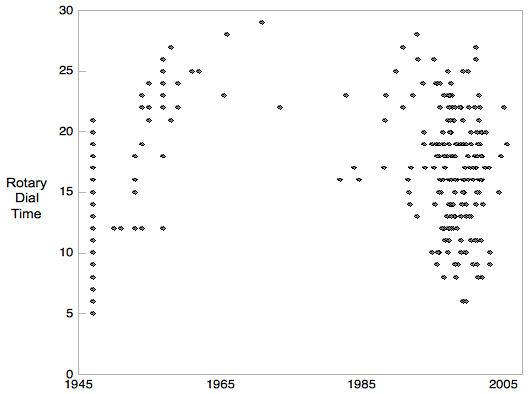I was curious as to how rotary dial phones affected the distribution of area codes over time; would the speed at which an area code on a vintage phone really matter to Ma Bell? With a little research, I was able to make this chart:

On the y-axis, we have the time it takes to dial the area code on a rotary phone (the number of pulses sent)—this would be the sum of all the digits in the area code, plus ten for each zero. Area codes were introduced in 1947, and we definitely see consciousness regarding dialing time. New York receives the fastest area code, of course. (212 is the fastest because area codes cannot begin with 1, nor can they end in “11” due to their reserved status—411, 911, etc. At the time, the second digit had to be 0 or 1, precluding the other five-pulse area code of 221 from existing. To this day, it is not in use.) The other original area codes try hard to be quick to dial.
As telephones become more popular, we see new area codes being created for different locales. It’s not until the late ’80s that we see real splitting of area codes with the rise of fax machines, and in the ’90s with mobile phones.
With the number of phones increasing to one per person with mobile phones, we quickly saturated our existing area codes and an area code explosion emerges. Fortunately, touch tone phones had become more popular in the ’70s, letting us not care at all about the number of pulses it took to dial. These new area codes are fairly normally distributed.
Trivia I can’t leave out
The “worst” “area code” issued, with a dial time of 29, is 900, assigned to—ahem—“premium services.” The runners-up? San Bernardino, CA’s 909 created in 1992 and 1966’s 800 tie at 28.
The lowest numerical area code in use is 201 (\d00s are reserved). Hackensack, NJ is the recipient of this prize—probably because AT&T was headquartered there.
P.S.: I managed to do this whole investigation without listening to Ludacris once.